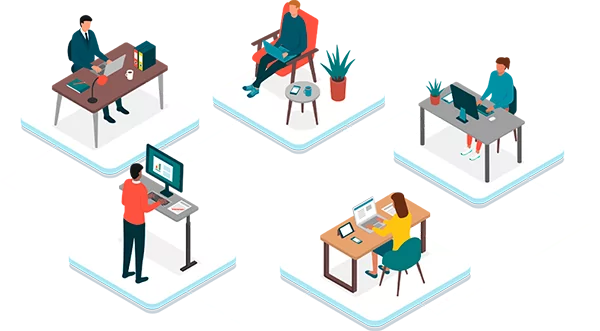With several potential problems and pitfalls, developing software is never an easy task. Thankfully, a software development life cycle plan can help you streamline the process and lower the chances of running into a range of issues.
By breaking down each task into digestible chunks, your team of developers will be able to create a piece of software that achieves your goals. But what exactly does the SDLC consist of, and what is the best way to implement this into your next project?
Take a look below to see the 7 main phases of the software development life cycle and a guide to some of the most popular methodologies used in the industry today!

What Is Meant By Software Development Life Cycle (SDLC)?
Software Development Life Cycle, or SDLC for short, is a specific process used by development teams across the globe to develop software. The main goal of the SDLC is to streamline software development and provide guidance to development teams.
By splitting up the entire software development process, you can easily focus on specific tasks, which will help you produce a robust piece of software. It can also ensure that you are staying within budget and that teams can effectively communicate with each other.
Key Phases Of The Software Development Process
1. Planning
One of the most important stages of any software development process is the planning phase. In this phase, the current project leaders will discuss the goals of the project and decide whether or not it is feasible.
The development team structure will be decided during this phase, and stakeholders will regularly input with feedback. Conversations between the developers and stakeholders are critical to ensure the team and the clients are on the same page.
Another important facet of the planning phase is deducing the scope of the overall project. It’s important to decide whether the current goal for the project is feasible and how many people will be needed on the development team.
2. Analysis & Requirements
Similar to the planning phase, and often implemented alongside it, is the analysis and requirement phase. Here the team leaders will figure out what the end goals of the development should look like and whether or not things need to be cut to reach the final goal.
During this stage, developers will also commonly discuss the hardware and software requirements they may need during development – although this is more common in the design stage. Again, this will help the team leader decide which developers work on specific aspects of the design phase.
This is also where the software requirement specification document, or SRS for short, will be written. The SRS document is essential and will be used throughout the entire project life cycle, especially in the design and development stages.

3. Design
The design phase is extremely similar to the planning phase and is where you will settle on the best way to tackle software development. For example, if your final piece of software features a user interface, then this is the stage where you will typically design the layout.
Generally, databases will also be designed in this stage, which can be a significant part of any software product. Again, working collaboratively to outline design specifics can help a project find its feet and ensure that developers know the final goal they are working towards.
4. Development
The main stage of any software development project is the development stage. First, the developers will write code and develop the software application using the outlined plan and software requirement specification documents.
Thanks to the planning and design phases, developing software for your clients should be fairly straightforward. As long as the goals are clearly defined and all developers know what language they should be using, development can be the most enjoyable part of the process.
Try to hit as many targets as you can to improve overall customer satisfaction. Spending more time here will help you avoid a lengthy testing stage and get your product out on the market or in the client’s hands faster!
5. Testing
Testing is a crucial phase, especially if you want your software to be a success. During this phase, developers will test every aspect of the developed software to ensure it works as intended and won’t break during use.
One of the best ways to test software is to emulate its use by a potential end-point user by recreating the user’s environment. This way, you can be sure that it can achieve exactly what you set out to accomplish.
A large majority of testing can be done using automated systems. However, it is still important for the developers to explore every facet of the complete developed software.
6. Deployment
This phase is exactly what you would expect, releasing your software either to the public or to a specific client. There are various deployment methods, such as releasing onto an online store or a website, but most can be automated.
You will need to consider a few factors before fully developing a finished piece of software, such as price and integration methods. For example, you may need to help a company integrate your software onto their machines.
7. Maintenance
Once the completed software has been released, it is still important to offer constant maintenance and updates. One of the most important aspects of the maintenance phase is to quell any missed bugs during the testing phase.
The maintenance phase is also where teams decide whether they want to update the current software or create a new suite if needed. Again, depending on what the software is, it may be beneficial to keep adding additional features instead of starting the development process from scratch.

Need Expert Guidance?
We provide fully managed end-to-end solutions for operators and service companies needing expert guidance.
Take advantage of our unique {SD:UK} CTO as a Service solution. Our experts help you to formally capture requirements, create a system specification and then fully manage the implementation of your project for a successfull delivery.


Different Software Development Life Cycle Methodologies
Waterfall Model
The waterfall model is easily one of the most traditional development cycles that software development teams often fall back on. As you might guess from the name, a waterfall model is where the previous project phase will drip into the next phase.
In terms of reliability, few methodologies are as reliable as the waterfall model. However, most companies now use an AGILE methodology. The main reason the waterfall model is so reliable is that you can focus on a specific phase at a time.
However, the main drawback to this focus is that the waterfall methodology is fairly slow and can lengthen the project life cycle. As all phases of software development rely on the previous steps, you need to ensure a single phase is fully completed before moving on to the next.
AGILE Model
The most common methodology in the software development world is an AGILE model. The main purpose of an AGILE model is always to put the customer first and ensure they get the product they have paid for.
Using an AGILE model throughout the planning and design process, you will constantly rely on user input to develop a robust software project. However, AGILE offers the flexibility of adapting to the user’s needs, so you don’t need to go back to the start to add a new feature.
Communication is vital for an AGILE methodology to work fully, with regular meetings known as ‘Scrums‘ being used to bring the team together. Goals will be established during these Scrums that will then be worked towards using a method known as Sprints.
Sprints are established periods where the developer will entirely focus on a particular aspect of the software. By balancing user feedback and efficient development methods, the AGILE software model can be extremely efficient.

DevOps Model
The DevOps model is slightly different from most other software development methodologies as the clients who will be using the software will participate in the software’s development. This can benefit the developers as it helps ensure the software is suitable for the user.
This model shares some similarities with the AGILE methodology as it utilizes end-point users to help guide the team through the development process. However, it does come with a few drawbacks due to its reliance on external contacts.
As the DevOps software model relies heavily on external users, communication is critical. Unfortunately, this means that more time is needed to adapt the feedback, but the overall development cost may be higher too.
Although there are a few drawbacks to the DevOps model, it is incredibly effective in mission-critical situations and ensures the end goal perfectly matches the client’s needs!
Spiral Model
The Spiral model is one of the most inventive methodologies used in software development. It works at each life cycle phase, and the developers will choose a different development method to use during that specific phase.
One of the best advantages this offers is that you can constantly adapt your development process to suit your current goals. However, it can be hard to successfully implement this when working in a large team as it can take a long time to plan for.
It also requires specialist knowledge, which means your team can quickly become overwhelmed without the right project manager. However, if you are looking for an extremely flexible methodology, the Spiral model is one of the most adaptable options.

Iterative Model
The Iterative Model is unique compared to other methodologies, as it relies on quickly developing a piece of software, then constantly building on the foundations. Once the initial development is complete, the team will figure out the next step and update the software.
This will continue until either a final complete product is produced or the team decides to develop a whole new piece of software. Iterative models are most commonly used in larger applications so that the user has something to work with whilst new features are being constantly added.
Due to the constant update requirements, it can be hard to establish a scope for iterative projects. However, an Iterative model can be the perfect choice for large-scale software projects with enough planning and communication.
Other SDLC Models
There is a range of other software development life cycle models, but most are just adaptations of the five you can find above. Some of the most popular variants are:
- V-Shaped Model: This is essentially the waterfall methodology with a few tweaks. Instead of just moving from one phase to the next, the V-shaped model implements validation and testing throughout the entire development cycle.
- LEAN Model: This is an adaptation of the lean manufacturing principles and practices first implemented by Toyota. It is almost a mix between AGILE and Iterative methods, where a first draft is developed, and then the developers will use user feedback to improve it constantly.
Although we have covered most of the common methodologies used in software development, they are just too many to break down. As long as you are familiar with the most popular types out there, you should be able to finish your software project successfully.
If you are lost and can’t decide which SDLC model is best for your project, get in touch with us today. We offer software advice and guidance to help you get your software out on the market. You can find out more about our advice service here!


IT Outsourcing Done Right!
Outsourcing is no longer about just saving money, it is a strategic tool for accessing highly qualified experts to compliment your team and accelerate project delivery. The {SD:UK} team has an excellent track record for delivering high quality projects on time and on budget. Reach out to us for a free consultation with one of our experts.

How To Apply Software Development Life Cycle Best Practices
Careful planning
Careful planning is the best way to ensure the final piece of software is what the client expects and that costs don’t exceed your development budget. In addition, without careful planning, you may bump into unsolvable issues that can put a hold on the entire software development lifecycle.
The software development life cycle has an entire phase dedicated to planning, so be sure to make the most out of the planning step. This way, you can not only help future development, but you can also ensure that you have the capabilities to complete the project smoothly.
Secure Source Control
No developer wants to lose the source code of their entire software project, which is why source control is vital. Ideally, you will want to store a copy of your source code in a secure physical location that only project managers and trusted team members can access.
You may also want to consider uploading the source code to a virtual storage system, such as the cloud. If you store it virtually, ensure that access is secure and that the code itself is encrypted so the code cannot be accessed for malicious reasons.
As always, backups should be frequently made of all aspects of the software project. This means that if one copy is lost, you can immediately access the backup code without needing to restart development.
Ensuring your cyber security is up to scratch is incredibly important if you want to prevent malicious access to your source code!
Effective team management
When working in a large or multiple development teams, you will want to ensure that all members work towards the same goal and collaborate effectively. One of the best ways to achieve this is by selecting a specific developer, or multiple developers, to be team managers.
This is even more apparent if you are working across long distances. Establishing central communication points with a strong leader can help keep all developers on the same page, and that process is as streamlined as possible.
Continuous Integration (CI)
One of the biggest problems that most developers will face for large-scale projects is the final integration. Stitching together a large project can be challenging for even the most experienced developers, and some aspects of the software may even be incompatible.
To avoid this becoming an issue, continuous integration (CI) should be implemented. This is where, at regular intervals throughout development, all developer’s code is integrated. Compatible programming languages and libraries should also be used to avoid incompatibility issues.
Sites such as GitHub offer an incredibly effective way to maintain integration and can be a great way to ensure that the entire project remains compatible. CI also helps avoid duplication and loss of work, so there is truly no reason to implement it into the software development cycle.
Continuous Deployment (CD)
If you work alongside a client who needs quick access to the software, then continuous deployment (CD) can be used. Similar to an iterative methodology, CD is where a team will develop software in short cycles.
The main advantage to this is that it means your project could be released at any time during development. It also allows you to easily set up an automatic deployment method, so you don’t need to deploy your software to the relevant sites and stores manually.
When implementing CD you need to be careful that code isn’t released that will completely break the system. But if you have a reliable team manager and are looking for a way to keep your project constantly deployed, then CD may be worth implementing.

Final Thoughts
As difficult as software development can be, the SLDC process is designed to help ensure the entire cycle is streamlined. Development teams around the globe will rely on the software development life cycle to produce high-quality applications, and you should consider implementing them into your project too!
As difficult as software development can be, the SLDC process is designed to help ensure the entire cycle is streamlined. Development teams around the globe will rely on the software development life cycle to produce high-quality applications, and you should consider implementing them into your project too!
fAQs
No, it’s also about changing the entire way a business operates and delivers value to its customers.
Yes, digital transformation is not just for large corporations; small businesses can also benefit significantly.
A culture open to change and innovation is crucial for successful digital transformation.
Success is typically measured using KPIs that are aligned with business objectives.
The cost can vary, but the investment often leads to long-term benefits and savings.
It often involves upskilling and may change job roles, but it aims to create a more efficient and agile work environment.
All industries are affected, but retail, healthcare, and finance are often the most impacted.
Yes, common reasons include lack of clear objectives, resistance to change, and inadequate technology.

